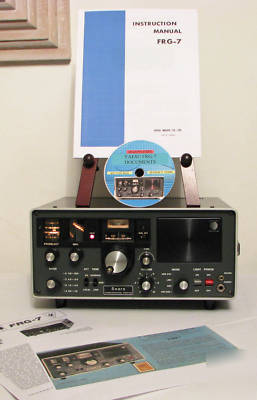Chicago Industrial Reuse and Parts Blog-Newsgroup > West Chicago
> Scrap Metal Only
> Yaesu frg-7 shortwave ham radio receiver **classic**
Yaesu frg-7 shortwave ham radio receiver **classic**
This Yaesu FRG-7 is in very nice original condition. I have taken a variety of pictures for you to see the cosmetic detail. Please refer to the pictures and feel free to ask any questions. Cosmetically, the unit is great condition with only minor signs of use. When looking at my pictures below, you will see that I have detail cleaned this FRG-7 and it now looks very nice. This is not bad for 30 year old receiver. The front panel is fantastic and the cabinet shows minor signs of wear. There looks to be a small ID engraving on the right side trim and I have provided a closeup of this. I encourage you to view my pictures below as I endeavor to give you a good glimpse at what is being offered in this sale.
Electronically, this FRG-7 works well and all the controls operate as they should and have been lubricated to eliminate intermittent contacts and noisy controls. All of the dial lamps illuminate as intended as a burned out tuning dial lamp was replaced to bring all lamps into working order. The FRG-7 is quite sensitive and I was able to pick up a variety of stations when testing it at my workbench. There is nothing lacking electronically and the receiver operates with great sensitivity.
If you look at the pictures, you will see that this is the "Sears" badged version of the Yaesu FRG-7. The only differences between the Sears badging and the Yaesu badging that I am aware of is the fact that there is a Sears plate on the front panel and the cabinet is black instead of the greenish grey color of the Yaesu cabinet. Thus difference are purely cosmetic and I really like this smart styling of the Sears unit in black.
This FRG-7 comes with a copy of the owner's manual and an interesting review of the FRG-7 seen in Practical Wireless in June of 1979. I am also sending along a printout of the unit as it appeared in the Sears catalog in 1977. In addition, I am including a pdf copy of the manual on CD along with service notes to keep this receiver operating at it's peak for many years to come. The CD contains a wealth of information about mods and specific improvements or operation notes concerning the FRG-7 receiver and this CD probably offers more details than any other CD that I have included with all the radios that I sell. This CD is not for sale and is intended to accompany this receiver into the hands of the new owner.
For those of you who are not familiar, let me tell you what makes this receiver so special. The circuitry was developed by Dr. Trevor Wadley and later employed by Yaesu in this FRG-7. The shortwave recievers of the day were not very stable and typically there was a certain amount of drift when tuned in to a station. You can imagine how annoying or even frustrating this can be to have to retune the circuit from time to time, especially on military frequencies or weak signals. Anyway, Dr. Wadley invented a drift cancelling loop that used triple conversion circuitry to achieve it's goals. This was a leap forward in receiver technology and for about 25 years, this was considered state of the art technology. So advanced was this technology when applied to the FRG-7, that it allowed the user to zero into a frequency within 5 or 10khz. In today's digital readout technology standard, this may not seem like a real feat, but back then, this was considered outstanding.
You can read a brief bio of Dr. Wadely here:
http://en.wikipedia.org/wiki/Trevor_Wadley
Or a discription in detail of the famed "Wadley Loop" here:
http://www.qsl.net/vk3jeg/b_wadley.html
Another thing accomplished by the FRG-7 receiver is that it is highly sensitive...even by today's standards. Back in the 1970's when I was a lad in my teenage years, I used a D*rake SPR*4 receiver for my listening before attending college. With that receiver, a special antenna, and some perserverence, I heard many remote foreign and even domestic stations. I can recall awaking one Monday morning and tuning in to KFI on 640khz when smaller stations were off the air for the weekly maintenance and was able to copy news from an AM station in Los Angeles despite being situationed on the east coast. I notified the station and subsequently received a QSL card verifying my reception. At the time, I belonged to a shortwave listening club called SPEEDX and received all their monthly mailings. These mailings were essentially reception reports of various shortwave stations...many that were elusive or even intermittent. Anyway, the FRG-7 was always the most heavily used receiver of the time for DX reporting. It is a hands down DX machine that may not offer all the bells and whistles of today's receivers, but it does it's job well.
Another thing to note with these receivers is that they used a special bulb in the various dial lamps. There are at least 6 of these lamps total in the FRG-7 as they are utilized in the preselector for band selections and also in the main tuning dial to illuminate the frequency. Anyway, when they burn out, they are difficult to replace without a qualified person doing the installation. All of the bulbs in this FRG-7 light and illuminate adequately bright.
The FRG-7 has many nice features and I won't list them here as you can look at my pictures for this information. The coverage is for 500kzh to 29900khz and thus it covers the AM, Ham, Marine, Shortwave and CB bands. Sideband reception allows you to listen in on ham radio operators, marine transmissions, or aeronautical or marine weather. As mentioned already, all of the knobs, switches and dials work properly on this FRG-7.
This receiver is still considered one of the finest receivers made and rates highly among collectors, dxers and shortwave enthusiasts in general. Yes, you can purchase a similarly priced contemporary receiver made out of plastic that has some bells and whistles not found on this FRG-7, but that is the fun of a vintage unit....to accept it as it is based on the prevailing technology of the day. Classic auto collectors don't typically expect to find power windows, automatic transmissions, or CD player in a car that originated from the 60s. Likewise, this unit does not have a sync detector or passband tuning, but manages great reception considering it's analog readout. It is a highly sensitive consumer receiver.
In Fred Osterman in his book "Shortwave Receivers Past And Present" says that this receiver is probably the best value in used receivers. Here are some reviews and additional notes:
http:// /rx/frg7.htm
On the eHam website, you will note that the FRG-7 still rates a total of 4.8 out of a possible 5. This is amazing for a receiver that is now about 30 years old. Here is the eHam review:
http://www.eham.net/reviews/detail/979
http:// /FRG7/index.html
Penna residents are reminded of their responsibility to pay the 6% state sales tax
Thank you once again for taking the time out of a busy day to look at this FRG-7 receiver.



